Folks are always asking – “how come we seem to have so many problems with buildings today?” We never seemed worry about rot, corrosion and mold before. What’s going on? What’s different? Is it workmanship? Builders and contractors are pretty bad today, right? And the trades, they’re hopeless, no one speaks English and they all eat funny food and dress strange.1 Nope, its not workmanship and the trades - it is always convenient to blame workmanship and the trades when you don’t understand the problem.
If you do the wrong thing right, it’s still wrong? Right? This is the basic difference between quality control and quality assurance. Quality assurance is figuring out what the right thing to do is. Quality control is executing it. For most of the past few decades we have been focusing on quality control and have been missing the quality assurance part. We have been doing the wrong things – but really well. We have missed some basic fundamental changes to our industry.
Five fundamental changes to building construction have occurred in the last 50 years – they happened so gradually, so insidiously that we missed their enormous significance. The five fundamental changes are:
Increased thermal resistance (Photograph 1);
A change in the permeability of the linings that we put on the inside and outside of building enclosures (Photograph 2 and 3);
Water and mold sensitivity of building materials(Photograph 4);
The ability of the building enclosure to store and redistribute moisture (Photograph 5); and
Complex three dimensional airflow networks that inadvertently couple the building enclosure to the breathing zone of the occupied space via the mechanical system.
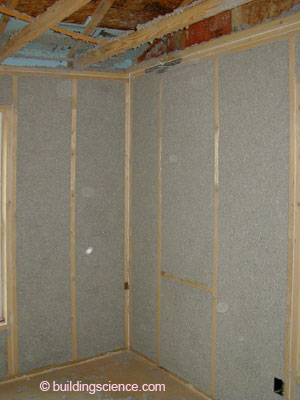
Photograph 1: Increased Thermal Resistance— Lots and lots of thermal insulation in the building enclosure. Spray applied cellulose with insulating sheathing in a wood frame wall.
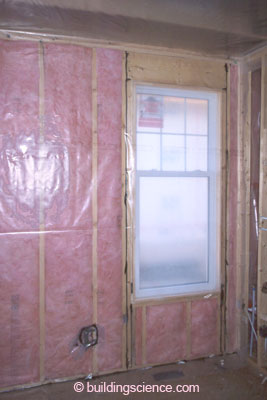
Photograph 2: Impermeable Interior Lining—Polyethylene vapor barrier on the interior of a wood frame wall causing mischief.
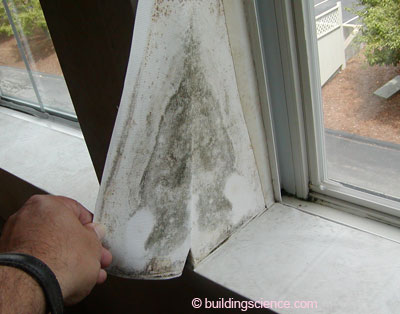
Photograph 3: Vinyl Wallcovering—Bad, very bad, very bad indeed.
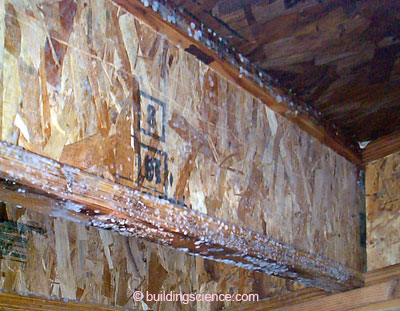
Photograph 4: Mold Sensitive Materials—Engineered wood materials manufactured from OSB and composite wood layers. Mold food par excellence.
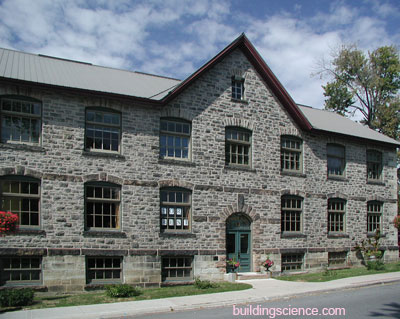
Photograph 5: Big Hygric Buffer—Lots of moisture storage in old mass assemblies constructed from rocks, mortar, bricks and plaster.
Fundamental change number one is reducing the drying potential of the enclosure by adding thermal resistance. One of the reasons older buildings were so durable is that when they got wet they didn’t stay wet very long. Repeated wetting followed by repeated drying was never a problem. Older buildings got wet but they dried quickly - what made it all work was massive energy exchange. The energy flow across building enclosures allowed them to dry both to the outside and inside. What changed is that we have steadily reduced the drying potential of the building enclosure by increasing thermal resistance thereby reducing energy flows and drying. Energy pigs were pigs but they were durable pigs. It gets worse. As surfaces got colder they also got wetter since most of the surfaces were hygroscopic. Hygroscopic surface moisture contents are driven by relative humidity. It was a double whammy.2 Insulation made less energy available for assemblies to dry – and the same insulation made the assemblies wetter because relative humidity at surfaces went up as well.
It should be no surprise to anyone that we are going to dramatically increase the amount of thermal resistance in our building enclosure in the near future —not just roofs, walls, foundations and slabs— everywhere. And the consequences of that are going to be a further reduction in drying potential. We are going to have to compensate for that with a reduction in wetting potentials, better materials, clever design, and a better understanding of the physics.
Fundamental change number two is a reduction in the water vapor permeability of the enclosure linings that we put on the inside and outside. We have had a huge reduction in water vapor transmission to the inside with the unfortunate trend to plastic vapor barriers, vinyl wall coverings and foil-faced fiberglass batts. On the outside we have gone from plywood to OSB and a huge reduction in breathability. And now we are going to insulating sheathings made out of impermeable foams – and those few foams that do breathe are faced with impermeable plastic films or are foil-faced. So now we have a lining on the outside that doesn’t breathe and a lining on the inside that doesn’t breathe. The coup de grace is that we fill the space between the two with lots of fluffy stuff that provides thermal resistance and then we install a water injection system called a window.3
You can’t put a vapor barrier on both sides of the assembly. Let me repeat that in case you are an architect4—you can’t put a vapor barrier on both sides of the assembly. You can put a vapor barrier on one side or the other not both—someone is going to have to make a decision. We can design buildings with vapor barriers on the outside and have them work pretty much everywhere – if we keep them warm during heating or if we drain them. It is much more difficult to design buildings with vapor barriers on the inside – except in cold climates – but we can do it as well.
Folks are going to have to make design decisions depending on where they are to put one on the outside or on the inside, but not on both sides. We can design around all of this. We just haven’t taken advantage of that. We have not elected to control the permeability of the linings. In fact, in many cases, we have put up regulatory impediments interfering with the ability and flexibility to control the permeability of the linings on both the inside and outside of the building enclosure.
Fundamental change number three is the water and mold sensitivity of our building materials. The water and mold sensitivity of our building materials is increasing. OSB is not as resistant to mold and water as plywood. Paper faced gypsum board is not as resistant to mold and water as plaster. Particleboard is worse than OSB. An engineered I-joist is not as resistant to mold and water as dimensional lumber such as a 2 x 10 joist or rafter. As we have moved down the process stream from timber to engineered materials, each step of the way, the processing makes the products more water and mold sensitive.
Let’s take a small digression and look at durability, the moisture balance and that pesky and increasingly more common annoyance - mold. Mold is a water problem. No water, no mold. Repeat after me: no water, no mold. In one of those counterintuitive things that make life interesting we have more mold but we don’t have more water. Why? The water that we have always had is hanging around longer in building materials that can’t tolerate it.
When the rate of wetting is greater than the rate of drying we have accumulation. When the quantity of the accumulated moisture exceeds the moisture storage capacity of the material, system or assembly we have a problem. And that storage capacity is time, temperature and material specific.
Adding thermal resistance (fundamental change one) reduces the rate of drying. Changing the permeability of the linings (fundamental change two) further reduces the rate of drying. Using OSB and engineered framing materials (fundamental change three) reduces the moisture storage capacity.
I remember framing subfloors with 2x10s and plywood over a crawlspace. The floor assembly remained uninsulated. Now we use an engineered framing I-joist and OSB – and insulate the cavity with fluffy stuff, which one gets mold faster? The I-joist, the OSB and the fluffy stuff: same exposure, same everything. The things that changed are the materials and the energy flow resulting in a huge increase in water and mold sensitivity with a corresponding increase in dwell time of moisture in the assembly. And we act surprised when we talk about how much of a mess today’s crawlspaces are.
Fundamental change number four relates to the hygric buffer capacity of the building enclosure. You used to be able to store a lot of water in buildings – when we constructed them out of bricks and plaster and big pieces of wood. You can’t store much water in the paper facing of gypsum board and a steel stud wall system. Older buildings could tolerate incidental water leakage from leaking windows, missing flashing and the odd plumbing leak. Things sure have changed. How much water can a steel stud hold? Zero. Compare that to an old multi-wythe masonry wall. Which wall system is going to require perfect windows, perfect doors, perfect flashing and perfect maintenance forever? The old mass masonry wall or the new steel stud and gypsum sheathed wall?
Do you realize that in the last century, the hygric buffer capacity of the typical building in North America has decreased two orders of magnitude? Those older buildings were like boxers in the ‘50s that could take a punch – a moisture punch – that they could shake off. A modern building is like a boxer with a glass jaw where a single moisture event puts the building down.
Fundamental change number five is that buildings have become complex three dimensional airflow networks that inadvertently couple the building enclosure to the breathing zone of the occupied space via the mechanical system.
The modern commercial and residential building is hollow – constructed of studs and joists and rafters and trusses all covered with sheathings with cavities that are empty (Photograph 6) – or when they are filled they are filled with fluffy stuff that does nothing to retard airflow. And everything is connected to everything else. Dropped ceilings are connected to exterior walls, interior walls to roof assemblies and foundations. And all these hollow spaces are covered with perforated sheathings – unintentionally perforated with electrical outlets and other services, but perforated never-the-less. Into this three-dimensional airflow network we add HVAC systems that use building cavities to convey air. Dropped ceiling return plenums in commercial buildings. Panned floor joists and stud cavities as return ducts. Everything sucks. And when it doesn’t suck it blows. Interstitial negative and positive pressure fields are the norm not the exception.

Photograph 6: No Hygric Buffer—Not a lot of moisture storage in hollow steel stud walls sheathed with gypsum.
What is the result? We have now coupled this hollow three-dimensional airflow network via the mechanical system to the breathing zone of the occupied space.
In the last 50 years my generation of engineers and architects and contractors has managed to turn the building enclosure into the contaminant and the mechanical system into the contaminant Interstate that couples the enclosure to the breathing zone of the occupied space. What a mess. We had better come to terms with this – and soon.
We are not going to get rid of insulation. We are going to have more. We are not going to get rid of impermeable materials. We are going to have more. We are not going to get rid of mold and moisture sensitive materials. We are going to have more. We are not going to get rid of hollow buildings. We are going to have more. But, by gosh5 we had better not connect the HVAC system to this mess or we are doomed. Even, better, we need to clean up the mess.
Where do we start? First, absolutely do not use building cavities to distribute air. Air belongs in ducts. And it belongs in tight ducts. This dropped ceiling negative pressure plenum connected to the exterior walls nonsense has to stop. And, residential contractors, stop with the panned floor joist and stud cavity return stuff (Photograph 7 and 8).
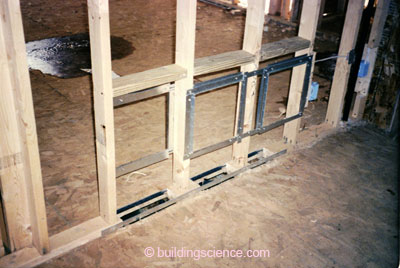
Photograph 7: Sucking on a Wall—Stud cavity return system couples interstitial cavities directly to the HVAC system.

Photograph 8: Sucking on a Floor—Panned floor joist return system couples floor framing directly to the HVAC system.
Next, pan flash all window and door openings in all buildings everywhere all the time no matter what. And let’s all rediscover flashings, and drainage planes and rainwater and ground water management. Drain the rain on the plane. Repeat after me, drain the rain on the plane…
Then, no more double vapor barriers. This should now be easy. The code has been changed. You can all thank me later. Come on folks, no vapor barriers on the inside of air-conditioned buildings. How hard can this be? If you are going to use an impermeable insulating sheathing do not, and I repeat, do not install a vapor barrier on the interior of the assembly.
On to the materials: no paper products in wet areas; no paper faced gypsum in firewalls and as exterior sheathing; no greenboard behind tile; protect the OSB and engineered framing.
Every cladding should be back-ventilated and drained everywhere all the time no matter what. Why we are still arguing about this baffles me. This was figured out by the generation before the generation before mine…
And speaking of my generation, let’s help the youngsters get it right. We currently have a language, terminology and understanding problem. Drainage planes should not be confused with air barriers that should not be confused with vapor barriers. We need to get the language of our profession straight. If we can’t call things by their proper names how can we get the understanding that goes with them applied in the real world?

Photograph 9: Sucking on a Wall Part Deux—Commercial return plenum draws air out of exterior walls into the return side of the HVAC system and then subsequently connects to the breathing zone of the occupied space.
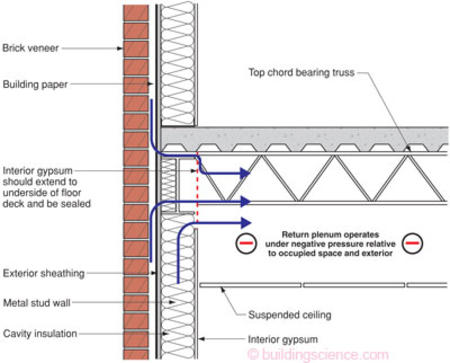
Figure 1: Sucking on a Commercial Wall—Flow out of wall cavity into return plenum. Three-dimensional airflow network flow at its best. The enclosure is the contaminant, the HVAC system is contaminant vector. Perfect.
Every cladding should be back-ventilated and drained everywhere all the time no matter what.6 Why we are still arguing about this baffles me. This was figured out by the generation before the generation before mine . . . And speaking of my generations, let's help the youngsters get it right. We currently have a language, terminology and understanding problem. Drainage planes should not be confused with air barriers that should not be confused with vapor barriers. We need to get the language of our professions straight. If we can't call things by their proper names how can we get the understanding that goes with them applied in the real world?
Further Reading
BSI-002: The Hollow Building
BSI-027: The Material View of Mold
BSI-029: Stucco Woes—The Perfect Storm
BSI-009: New Light in Crawlspaces
BSI-028: Energy Flow Across Enclosures
The Mold Explosion: Why Now?
Footnotes:
- We're of course talking about the Irish. Or are we talking about the Germans? Or is it the Québécois? Immigrants have always built our infrastructure and have always been blamed for stuff that was not their fault. So lay off the Hispanics or this Czech is going to take a run at you.
- Triple whammy, actually, with mass construction. Capillary transport is also a function of temperature. Cold capillaries carry more water farther than warm capillaries. Europeans know this with their "rising damp" problems. Heating mass buildings does make them less wet and helps dry them.
- There are only two kinds of windows in the world – those that leak and those that will leak.
- The architects can explain it to the engineers, contractors and interior desecraters later.
- This was not the phrase I wanted to use here, but apparently there still are a few restrictions that apply to me…
- OK, there are a few exceptions, like stucco directly applied on a masonry mass wall. And a water managed EIFS that is drained but not ventilated. But you all get the idea.
